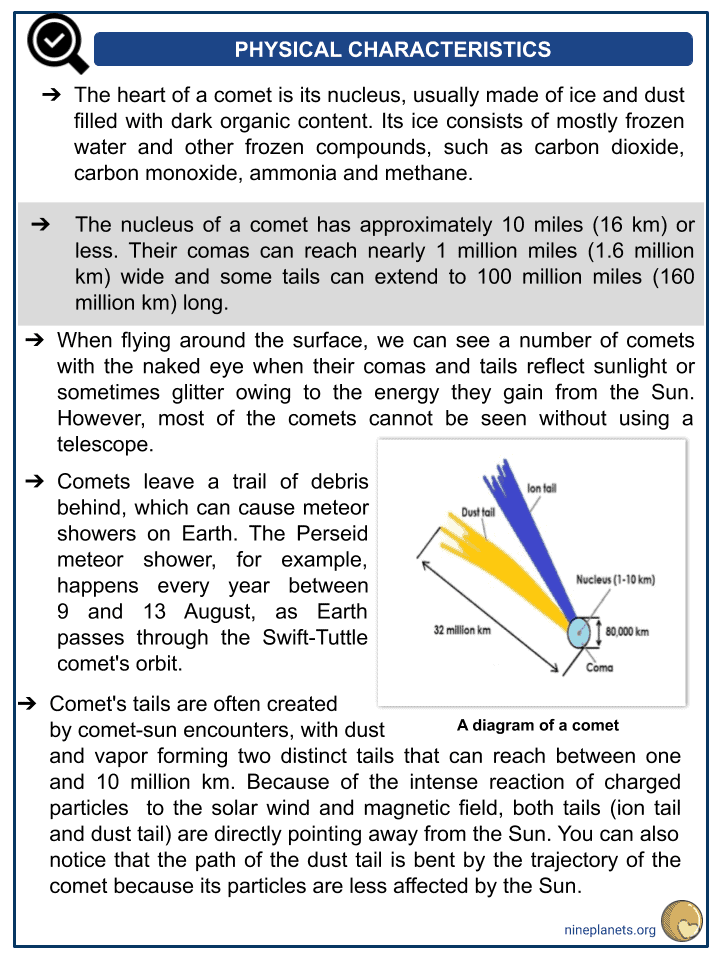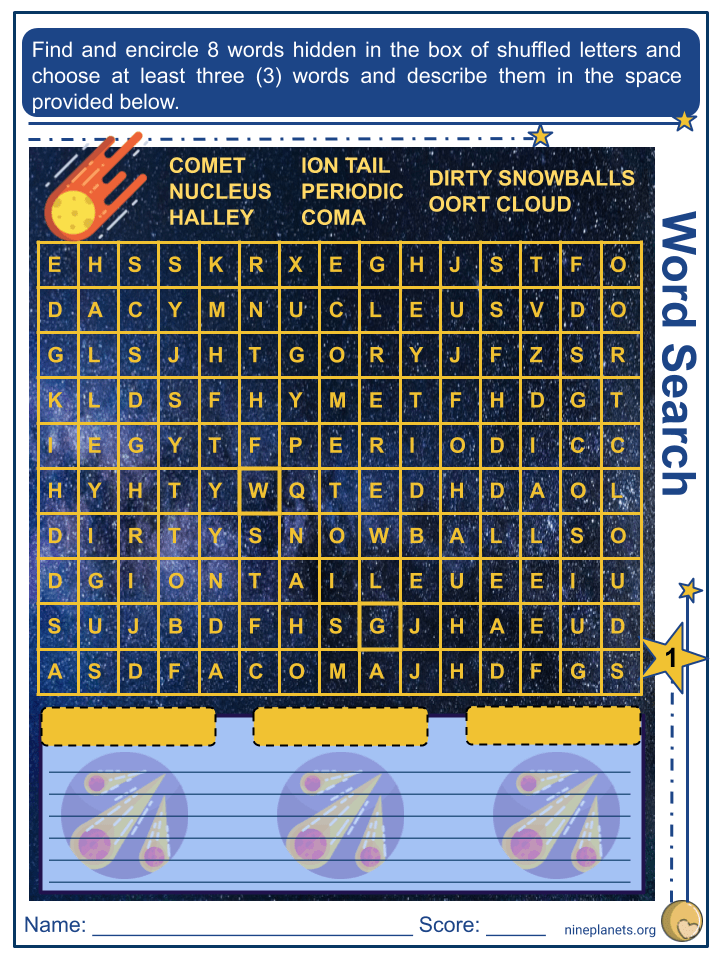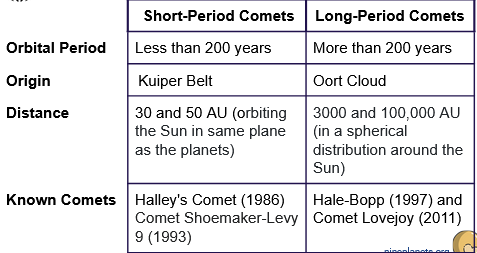Download Comets Worksheets
Click the button below to get instant access to these premium worksheets for use in the classroom or at a home.

This worksheet can be edited by Premium members using the free Google Slides online software. Click the Edit button above to get started.
Download free sample
Not ready to purchase a subscription yet? Click here to download a FREE sample of this worksheet pack.
Resource Examples
Click any of the example images below to view a larger version.




Key Facts & Information
- Comets are snowballs made up of frozen gas, rock and dust that orbit the Sun. They heat up and leave a trail of glowing dust and gases. Unlike the other small bodies in the Solar System, comets have been known since antiquity. They are considered as excess materials that shaped the Solar System 4.6 billion years ago.
Quick Facts
- The term comet is derived from the Latin word cometa, meaning “long hair”.
- The four components of a comet are: nucleus, coma, dust and ion tail.
- A comet’s nucleus comprises much of the overall mass.
- Comets display a halo while passing around the Sun.
- A comet’s ion tail is the product of solar winds pushing the gas ions straight away from the Sun.
- A dust tail is a trace of dust and rough material left behind when it travels through the orbit course.
- Halley’s Comet is the most prominent comet. It was known from at least 240 B.C. The orbit renders it apparent from Earth every 76 years.
- Since July 2019, there are actually 6,619 identified comets. Scientists estimate that our planetary system contains up to one billion comets.
Physical Characteristics
- The heart of a comet is its nucleus, usually made of ice and dust filled with dark organic content. Its ice consists of mostly frozen water and other frozen compounds, such as carbon dioxide, carbon monoxide, ammonia and methane.
- The nucleus of a comet has approximately 10 miles (16 km) or less. Their comas can reach nearly 1 million miles (1.6 million km) wide and some tails can extend to 100 million miles (160 million km) long.
- When flying around the surface, we can see a number of comets with the naked eye when their comas and tails reflect sunlight or sometimes glitter owing to the energy they gain from the Sun. However, most of the comets cannot be seen without using a telescope.
- Comets leave a trail of debris behind, which can cause meteor showers on Earth. The Perseid meteor shower, for example, happens every year between 9 and 13 August, as Earth passes through the Swift-Tuttle comet’s orbit.
- Comet’s tails are often created by comet-sun encounters, with dust and vapor forming two distinct tails that can reach between one and 10 million km. Because of the intense reaction of charged particles to the solar wind and magnetic field, both tails (ion tail and dust tail) are directly pointing away from the Sun. You can also notice that the path of the dust tail is bent by the trajectory of the comet because its particles are less affected by the Sun.
Parts Of A Comet
- Nucleus – Relatively solid and stable, mostly ice and gas with a small amount of dust and other solids.
- Coma – A dense cloud of water, carbon dioxide and other neutral gases sublimed from the nucleus.
- Dust Tail – Up to 10 million km long composed of smoke-sized dust particles driven off the nucleus by escaping gases; this is the most prominent part of a comet visible to the unaided eye.
- Ion Tail – As much as several hundred million km long composed of plasma and laced with rays and streamers caused by interactions with the solar wind.
Orbital Characteristics

History
- Comets caused wonder and fear in antiquity, and called “hairy stars” like flaming swords that shone unpredictably in the sky.
- The earliest findings of comets was from the third century B.C. Their sudden appearance was considered a symbol from the gods in ancient cultures. By upsetting starry sky’s equilibrium, they were regarded as bad omens.
- The natural philosophers in ancient Greece tried to find an explanation for this phenomenon.
- The apprehension of this “strong hand of Nature” reached its height in the Middle Ages. Comets were believed to represent horrific natural events including flooding, and earthquakes.
- They became a popular topic for newspaper forecasters in the 16th and early 17th centuries. A poem was also published 15th century, that describes a comet as somewhat dangerous to mankind since it may bring illness, death and other tragedies to all.
Astronomers
- Peter Apian 1495–1552 – He is the author of the book entitled Astronomicum Caesareum published in 1540 which was dedicated to the Emperor Charles V. Apian is the first modern-time astronomer to note that the tails of comets are pointed away from the Sun.
- Johannes Kepler 1571–1630 – The German astronomer known for his laws of planetary motion. Johannes Kepler assumed that the trajectories were straight lines and thereby disputed his own laws that attributed to a notion that planets move in elliptical orbits with the Sun in the center.
- Tycho Brahe 1546–1601 – The Danish astronomer Tycho Brahe realized that comets were separate celestial bodies. He calculated the brilliant comet parallax of 1577 and thereby decided that its size was about 230 Earth radii, equivalent to 1.5 million km, which implies that they existed above the moon. He was probably the first to assume that the comets had returned periodically.
- Johannes Hevelius 1611–1687 – An alderman and astronomer from Danzig believed in elongated parabolas and hyperbolas, correctly as we are now aware. The controversy over the proper shape of trajectories was properly described in his Cometographia treatise. The book was written in 1665 and also concerned the presence, type and description of comets.
- Isaac Newton 1642–1726 – Isaac Newton studied the meteor, and his trajectory equations verified his universal gravity principle. Edmond Halley also examined the comet. Newton’s calculations helped him evaluate 24 other comets’ orbits and estimate when they would reappear in the night sky.
- Edmond Halley 1656–1742 – In 1680, Edmond Halley, detected a huge comet. He clarified that the 1680’s comet actually had a “sharply bent” course. He was the first one to foresee a comet’s return when the comet reappeared in 1759. Since then this planet became regarded as the Halley’s Comet.
- Jan Hendrik Oort 1900–1992 – Jan Oort first proposed in 1950 that there could be a pool of frozen parts, possible comet nuclei, at the edge of the Sun’s gravitational power. The Oort Cloud is also considered the pool of ancient frozen artifacts from which certain comets are born.
- Gerard Kuiper 1905–1973 – He raised the idea of a disk-like band of comets circling the Planet from 30–50 astronomical units. In the 1990s, the presence of this million comet belt was confirmed and dubbed the Kuiper belt.
Most Well-Known Comets
- Comet Name: C/2011 W3 Comet Lovejoy
- Orbital Type: Long period comet
- Discovered by: Terry Lovejoy
- Discovery Date: November 27, 2011
- Last Perihelion: December 16, 2011
- Next Perihelion: C. 2633
- Comet Lovejoy was a Kreutz sungrazer, a comet whose path is very similar to the Sun at its perihelion, the position of its path nearest to the earth. Because it was visible from Earth during the Christmas holidays, it was also called “2011’s Great Christmas Comet”.
- Comet Name: C/1995 O1 Comet Hale-Bopp
- Orbital Type: Long period comet
- Discovered by: Alan Hale, Thomas Bopp
- Discovery Date: July 23, 1995
- Last Perihelion: April 1, 1997
- Next Perihelion: C. 4385
- Comet Hale-Bopp, officially C/1995 O1, was one of 20th century’s strongest and possibly most widely observed comets.
- Comet Name: 1P/Halley Halley’s Comet
- Orbital Type: Short-period comet
- Discovered by: Edmond Halley
- Discovery Date: 1758
- Last Perihelion: February 9, 1986
- Next Perihelion: July 28, 2061
- Halley’s Comet is a comet observable from Earth every 74–79 years. Halley is the only documented short-period comet frequently observable from Earth to the naked eye, and the only naked-eye comet that may occur twice in a lifetime.
- Comet Name: D/1993 F2 Comet Shoemaker-Levy 9
- Orbital Type: Short-period comet
- Discovered by: Carolyn Shoemaker, Eugene Shoemaker, David Levy
- Discovery Date: March 24, 1993
- Comet Shoemaker-Levy 9 was discovered in 1993, and was divided into over 20 pieces traveling across the world during a two-year cycle. In July 1994, it was torn apart and smashed into the giant planet.
Difference Between Comets And Asteroids
- Comets
- Contain a lot of ice, along with rock, and hydrocarbons.
- It is far from the Sun where its ices would not melt.
- Its ice melts when it is near the Sun, making its exterior changeable and unstable.
- Grow comas and tails as they reach the Sun.
- Originated from Kuiper Belt outside Neptune‘s orbit, and in Oort Cloud outside the Solar System.
- Orbit may be broken through the elongated orbit by losing comets, such that we see it in the inner Solar System.
- From about 6–25 miles in diameter.
- May have provided much of the water on Earth.
- Asteroids
- Composed of rock and metals.
- It’s built even closer to the Sun, where the temperature is too high to stay solid.
- Its exterior is firm and sturdy, showing craters in which other objects have collapsed.
- Its surface does not melt, nor produce comas and tails.
- Originated from Asteroid Belt between orbit of Mars and Jupiter.
- The orbit is steady and disc-shaped.
- Diameters vary from tiny rocks to over 600 miles.
- Also created craters on Earth that could have caused mass extinctions including dinosaurs.
Interesting Facts About Comet
- Comets come from the Kuiper belt and the Oort Cloud.
- These areas of space are way out in the Solar System far away from the Sun. The Oort Cloud is so far away we have never even seen it! The comets visible from Earth are most likely ones that came from the closer Kuiper belt which is near Pluto.
- There are millions of comets, and they are all orbiting the Sun.
- Most take less than two hundred years to do so, and others travel much slower, potentially taking millions of years to complete an orbit.
- Comets spend most of their years in the Kuiper belt and Oort Cloud
- Every now and again two comets can crash into one another. When this happened, they often change direction, and this can throw them out towards the inner Solar System.
- When a comet approaches the inner planets, it is warmed by the Sun.
- When this happens, it begins to melt and throws out dust and gas. This creates a head and the tail. The tail is the part of the comet we see in the sky. The tail always points away from the Sun. This means that sometimes the tail is behind the comet and sometimes in front. It all depends on whether the comet is traveling towards or away from the Sun.
- Traveling through a comet’s tail is not dangerous.
- Earth even passes through them. When this happens, we see a meteor shower.
- The word comet comes from the Greek word kometes meaning long hair.
- This is because of the way a comet’s tail can look like long flowing locks of hair.
- Like asteroids, comets are leftovers from the formation of the Solar System.
- We don’t know an awful lot about them at this point, but scientists believe they may hold clues to how the Solar System came to be.
- A comet’s nucleus consists of ice that may be as thin as a few meters wide or as big as massive rocks a million km long.
- When a comet is nearest to the Sun, it is called a “perihelion,” the “aphelion” the farthest away from the Sun in orbit.
- There is a lot of material that streams off of a comet. If the material comes into contact with Earth, the particles fall and appear as meteor showers.
- Once a comet gets close to the Sun the heat melts the ice and causes some of the ice to “sizzle”. Since there is no sound in space, this happens silently. Once the ice is close to the surface of the comet it can form a jet that looks something like a mini-geyser.
- There is a lot of material that streams off of a comet. If the material comes into contact with Earth, the particles fall and appear as meteor showers.
- As comets complete their orbits near the Sun they lose some of their mass in a process called “sublimation”. This is why a comet has a limited lifespan. Eventually, if a comet goes around the Sun enough times it will break up.
- Thanks to scientific discoveries of what makes up a comet we now know that although they are made up of frozen water and cold methane, ammonia, and carbon dioxide ices, we also know that they can contain a mixture of rocks, dust, and other bits of metallic materials from solar debris.
- Comets used to fill people with fear. That fear inspired businessmen to market ridiculous products to sell to those that feared comets, such as: umbrellas, gas masks, and even “Anti-comet” pills.
- We may see the yellow tail that follows a comet, but ionized gas gives a comet a second, blue, tail.